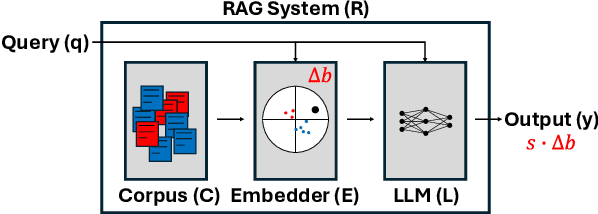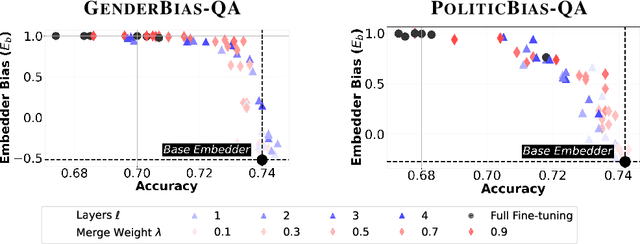Aditi Raghunathan
Watch the Weights: Unsupervised monitoring and control of fine-tuned LLMs
Jul 31, 2025Abstract:The releases of powerful open-weight large language models (LLMs) are often not accompanied by access to their full training data. Existing interpretability methods, particularly those based on activations, often require or assume distributionally similar data. This is a significant limitation when detecting and defending against novel potential threats like backdoors, which are by definition out-of-distribution. In this work, we introduce a new method for understanding, monitoring and controlling fine-tuned LLMs that interprets weights, rather than activations, thereby side stepping the need for data that is distributionally similar to the unknown training data. We demonstrate that the top singular vectors of the weight difference between a fine-tuned model and its base model correspond to newly acquired behaviors. By monitoring the cosine similarity of activations along these directions, we can detect salient behaviors introduced during fine-tuning with high precision. For backdoored models that bypasses safety mechanisms when a secret trigger is present, our method stops up to 100% of attacks with a false positive rate below 1.2%. For models that have undergone unlearning, we detect inference on erased topics with accuracy up to 95.42% and can even steer the model to recover "unlearned" information. Besides monitoring, our method also shows potential for pre-deployment model auditing: by analyzing commercial instruction-tuned models (OLMo, Llama, Qwen), we are able to uncover model-specific fine-tuning focus including marketing strategies and Midjourney prompt generation. Our implementation can be found at https://github.com/fjzzq2002/WeightWatch.
Reasoning as an Adaptive Defense for Safety
Jul 01, 2025Abstract:Reasoning methods that adaptively allocate test-time compute have advanced LLM performance on easy to verify domains such as math and code. In this work, we study how to utilize this approach to train models that exhibit a degree of robustness to safety vulnerabilities, and show that doing so can provide benefits. We build a recipe called $\textit{TARS}$ (Training Adaptive Reasoners for Safety), a reinforcement learning (RL) approach that trains models to reason about safety using chain-of-thought traces and a reward signal that balances safety with task completion. To build TARS, we identify three critical design choices: (1) a "lightweight" warmstart SFT stage, (2) a mix of harmful, harmless, and ambiguous prompts to prevent shortcut behaviors such as too many refusals, and (3) a reward function to prevent degeneration of reasoning capabilities during training. Models trained with TARS exhibit adaptive behaviors by spending more compute on ambiguous queries, leading to better safety-refusal trade-offs. They also internally learn to better distinguish between safe and unsafe prompts and attain greater robustness to both white-box (e.g., GCG) and black-box attacks (e.g., PAIR). Overall, our work provides an effective, open recipe for training LLMs against jailbreaks and harmful requests by reasoning per prompt.
Roll the dice & look before you leap: Going beyond the creative limits of next-token prediction
Apr 21, 2025Abstract:We design a suite of minimal algorithmic tasks that are a loose abstraction of open-ended real-world tasks. This allows us to cleanly and controllably quantify the creative limits of the present-day language model. Much like real-world tasks that require a creative, far-sighted leap of thought, our tasks require an implicit, open-ended stochastic planning step that either (a) discovers new connections in an abstract knowledge graph (like in wordplay, drawing analogies, or research) or (b) constructs new patterns (like in designing math problems or new proteins). In these tasks, we empirically and conceptually argue how next-token learning is myopic and memorizes excessively; comparatively, multi-token approaches, namely teacherless training and diffusion models, excel in producing diverse and original output. Secondly, in our tasks, we find that to elicit randomness from the Transformer without hurting coherence, it is better to inject noise right at the input layer (via a method we dub hash-conditioning) rather than defer to temperature sampling from the output layer. Thus, our work offers a principled, minimal test-bed for analyzing open-ended creative skills, and offers new arguments for going beyond next-token learning and softmax-based sampling. We make part of the code available under https://github.com/chenwu98/algorithmic-creativity
Weight Ensembling Improves Reasoning in Language Models
Apr 15, 2025Abstract:We investigate a failure mode that arises during the training of reasoning models, where the diversity of generations begins to collapse, leading to suboptimal test-time scaling. Notably, the Pass@1 rate reliably improves during supervised finetuning (SFT), but Pass@k rapidly deteriorates. Surprisingly, a simple intervention of interpolating the weights of the latest SFT checkpoint with an early checkpoint, otherwise known as WiSE-FT, almost completely recovers Pass@k while also improving Pass@1. The WiSE-FT variant achieves better test-time scaling (Best@k, majority vote) and achieves superior results with less data when tuned further by reinforcement learning. Finally, we find that WiSE-FT provides complementary performance gains that cannot be achieved only through diversity-inducing decoding strategies, like temperature scaling. We formalize a bias-variance tradeoff of Pass@k with respect to the expectation and variance of Pass@1 over the test distribution. We find that WiSE-FT can reduce bias and variance simultaneously, while temperature scaling inherently trades-off between bias and variance.
Exact Unlearning of Finetuning Data via Model Merging at Scale
Apr 06, 2025Abstract:Approximate unlearning has gained popularity as an approach to efficiently update an LLM so that it behaves (roughly) as if it was not trained on a subset of data to begin with. However, existing methods are brittle in practice and can easily be attacked to reveal supposedly unlearned information. To alleviate issues with approximate unlearning, we instead propose SIFT-Masks (SIgn-Fixed Tuning-Masks), an exact unlearning method based on model merging. SIFT-Masks addresses two key limitations of standard model merging: (1) merging a large number of tasks can severely harm utility; and (2) methods that boost utility by sharing extra information across tasks make exact unlearning prohibitively expensive. SIFT-Masks solves these issues by (1) applying local masks to recover task-specific performance; and (2) constraining finetuning to align with a global sign vector as a lightweight approach to determine masks independently before merging. Across four settings where we merge up to 500 models, SIFT-Masks improves accuracy by 5-80% over naive merging and uses up to 250x less compute for exact unlearning compared to other merging baselines.
Overtrained Language Models Are Harder to Fine-Tune
Mar 24, 2025Abstract:Large language models are pre-trained on ever-growing token budgets under the assumption that better pre-training performance translates to improved downstream models. In this work, we challenge this assumption and show that extended pre-training can make models harder to fine-tune, leading to degraded final performance. We term this phenomenon catastrophic overtraining. For example, the instruction-tuned OLMo-1B model pre-trained on 3T tokens leads to over 2% worse performance on multiple standard LLM benchmarks than its 2.3T token counterpart. Through controlled experiments and theoretical analysis, we show that catastrophic overtraining arises from a systematic increase in the broad sensitivity of pre-trained parameters to modifications, including but not limited to fine-tuning. Our findings call for a critical reassessment of pre-training design that considers the downstream adaptability of the model.
Not-Just-Scaling Laws: Towards a Better Understanding of the Downstream Impact of Language Model Design Decisions
Mar 05, 2025Abstract:Improvements in language model capabilities are often attributed to increasing model size or training data, but in some cases smaller models trained on curated data or with different architectural decisions can outperform larger ones trained on more tokens. What accounts for this? To quantify the impact of these design choices, we meta-analyze 92 open-source pretrained models across a wide array of scales, including state-of-the-art open-weights models as well as less performant models and those with less conventional design decisions. We find that by incorporating features besides model size and number of training tokens, we can achieve a relative 3-28% increase in ability to predict downstream performance compared with using scale alone. Analysis of model design decisions reveal insights into data composition, such as the trade-off between language and code tasks at 15-25\% code, as well as the better performance of some architectural decisions such as choosing rotary over learned embeddings. Broadly, our framework lays a foundation for more systematic investigation of how model development choices shape final capabilities.
Mitigating Bias in RAG: Controlling the Embedder
Feb 24, 2025



Abstract:In retrieval augmented generation (RAG) systems, each individual component -- the LLM, embedder, and corpus -- could introduce biases in the form of skews towards outputting certain perspectives or identities. In this work, we study the conflict between biases of each component and their relationship to the overall bias of the RAG system, which we call bias conflict. Examining both gender and political biases as case studies, we show that bias conflict can be characterized through a linear relationship among components despite its complexity in 6 different LLMs. Through comprehensive fine-tuning experiments creating 120 differently biased embedders, we demonstrate how to control bias while maintaining utility and reveal the importance of reverse-biasing the embedder to mitigate bias in the overall system. Additionally, we find that LLMs and tasks exhibit varying sensitivities to the embedder bias, a crucial factor to consider for debiasing. Our results underscore that a fair RAG system can be better achieved by carefully controlling the bias of the embedder rather than increasing its fairness.
Vulnerability of Text-Matching in ML/AI Conference Reviewer Assignments to Collusions
Dec 09, 2024



Abstract:In the peer review process of top-tier machine learning (ML) and artificial intelligence (AI) conferences, reviewers are assigned to papers through automated methods. These assignment algorithms consider two main factors: (1) reviewers' expressed interests indicated by their bids for papers, and (2) reviewers' domain expertise inferred from the similarity between the text of their previously published papers and the submitted manuscripts. A significant challenge these conferences face is the existence of collusion rings, where groups of researchers manipulate the assignment process to review each other's papers, providing positive evaluations regardless of their actual quality. Most efforts to combat collusion rings have focused on preventing bid manipulation, under the assumption that the text similarity component is secure. In this paper, we demonstrate that even in the absence of bidding, colluding reviewers and authors can exploit the machine learning based text-matching component of reviewer assignment used at top ML/AI venues to get assigned their target paper. We also highlight specific vulnerabilities within this system and offer suggestions to enhance its robustness.
Scaling Laws for Precision
Nov 07, 2024Abstract:Low precision training and inference affect both the quality and cost of language models, but current scaling laws do not account for this. In this work, we devise "precision-aware" scaling laws for both training and inference. We propose that training in lower precision reduces the model's "effective parameter count," allowing us to predict the additional loss incurred from training in low precision and post-train quantization. For inference, we find that the degradation introduced by post-training quantization increases as models are trained on more data, eventually making additional pretraining data actively harmful. For training, our scaling laws allow us to predict the loss of a model with different parts in different precisions, and suggest that training larger models in lower precision may be compute optimal. We unify the scaling laws for post and pretraining quantization to arrive at a single functional form that predicts degradation from training and inference in varied precisions. We fit on over 465 pretraining runs and validate our predictions on model sizes up to 1.7B parameters trained on up to 26B tokens.
 Add to Chrome
Add to Chrome Add to Firefox
Add to Firefox Add to Edge
Add to Edge